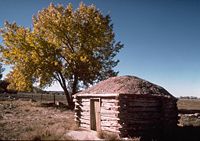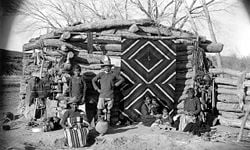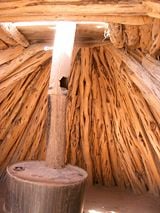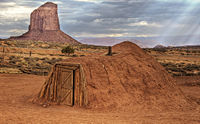Difference between revisions of "Hogan" - New World Encyclopedia
| Line 41: | Line 41: | ||
==External links == | ==External links == | ||
| − | Retrieved | + | Retrieved June 1, 2011. |
| − | *[http:// | + | * [http://navajopeople.org/navajo-hogans.htm Navajo Hogans] |
| − | * [http:// | + | * [http://xroads.virginia.edu/~ma97/dinetah/hogan.html Sacred Mountains as a Hogan and Other Closed Systems] |
* [http://www.firetreeinn.com/hogan.html Fire Tree hogan] | * [http://www.firetreeinn.com/hogan.html Fire Tree hogan] | ||
| + | * [http://navajo-arts.com/navajo-hogans.html Navajo Hogans] | ||
{{Native American Housing}} | {{Native American Housing}} | ||
{{Credits|Hogan|260786561}} | {{Credits|Hogan|260786561}} | ||
Revision as of 14:49, 1 June 2011
A hogan (pronounced /hoʊˈgɑːn/, from Navajo hooghan, IPA: [hoːɣan]) is traditionally the primary home of the Navajo people. Other traditional Navajo structures include the summer shelter, the underground home, and the sweat house.
Origins
The religious song The Blessingway describes the first hogan as being built by Coyote with help from beavers to be a house for First Man, First Woman, and Talking God. The Beaver People gave Coyote logs and instructions on how to build the first hogan, now known as a "forked stick" or "male" (áłchʼįʼ adeezʼá) hogan. The hogan resembles a pyramid with five triangular faces. Earth may fill the spaces between the framework logs, hiding the five faceted shape and creating thick, winter-protective walls.
Construction
Navajos made their hogans in this fashion until the 1900s, when they started to make them in hexagonal and octagonal shapes. The change in shape may have been due to the arrival of the railroad. A supply of wooden cross-ties, which could be laid horizontally to form walls of a larger, taller home, allowed the retention of the "female" hogan shape but with more interior room.
The hogan has many shapes and styles, depending on individual taste, tools, and the availability of material from which to make it. It is usually round and cone shaped, but now they make them square. Large trees provide long timbers and thus substantial expansion of the interior; if only shorter logs are available different building methods are required. Logs can be piled up, curving inward, so as to form a domed roof. The four-legged hogan has four main timbers supporting the walls. When trees are absent, stone is commonly used, producing a circular styled hogan (Thybony 1998). Regardless of the shape or form, the door always faces east to welcome the rising sun for good wealth and fortune.
Use
The "forked stick" or "male" Hogan contains a vestibule in the front and was used only for sacred or private ceremonies. This form of hogan is considered sacred to those who practice the Navajo religion.
The "circular" or "female" Hogan (tsé bee hooghan), the family home for the Diné people, is much larger and does not contain a vestibule. In it, the children play, the women cook, weave, talk, and entertain and men tell jokes and stories.
Variations
Many cultural taboos are associated with the hogan and its use. Should a death occur in the structure, the body is either buried in the hogan with the entry sealed to warn others away, or the deceased is extracted through a hole knocked in the north side of the structure and it is abandoned and often burned. A hogan may also become taboo for further use if lightning strikes near the structure or a bear rubs against it. Wood from such structures is never reused for any other purpose by a Navajo.
Contemporary variations
Today, while some older hogans are still used as dwellings and others are maintained for ceremonial purposes, new hogans are rarely intended as family dwellings.
Some tourist sites have taken to offering accommodation in hogans. For example, in Monument Valley, a region of the Colorado Plateau characterized by a cluster of vast and iconic sandstone buttes, there are Bed and Breakfast establishments where guests can sleep in a hogan built in the traditional Navajo way from juniper and ponderosa logs. These hogans have central skylights and either stone floors or the more traditional earth-packed floors.
ReferencesISBN links support NWE through referral fees
- McAllester, David P. 1987. Hogans: Navajo Houses and House Songs. Wesleyan. ISBN 0819561851
- O'Bryan, Aileen. 1993. Navaho Indian Myths. Dover Publications. ISBN 978-0486275925
- Pritzker, Barry M. 2000. A Native American Encyclopedia: History, Culture, and Peoples. New York, NY: Oxford University Press. ISBN 0195138775
- Thybony, Scott. 1998. The Hogan: The Traditional Navajo Home. Southwest Parks & Monuments Association. ISBN 1877856932
- Waldman, Carl. 2000. Atlas of the North American Indian, Revised Edition. New York, NY: Checkmark Books. ISBN 0816039755
- Waldman, Carl. 2006. Encyclopedia of Native American Tribes. New York, NY: Checkmark Books. ISBN 9780816062744
- Wyman, Leland C., and Berard Haile. 1970. Blessingway. Univ of Arizona Press. ISBN 978-0816501786
External links
Retrieved June 1, 2011.
| |||||
Credits
New World Encyclopedia writers and editors rewrote and completed the Wikipedia article in accordance with New World Encyclopedia standards. This article abides by terms of the Creative Commons CC-by-sa 3.0 License (CC-by-sa), which may be used and disseminated with proper attribution. Credit is due under the terms of this license that can reference both the New World Encyclopedia contributors and the selfless volunteer contributors of the Wikimedia Foundation. To cite this article click here for a list of acceptable citing formats.The history of earlier contributions by wikipedians is accessible to researchers here:
The history of this article since it was imported to New World Encyclopedia:
Note: Some restrictions may apply to use of individual images which are separately licensed.




